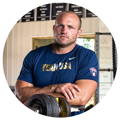Jefferson Curl For Hypertrophy Day
Jefferson Curl For Hypertrophy Day
When you hear Jefferson curl- are you thinking about your arms getting yoked? Oftentimes we hear “curl” and we think biceps, right? But the Jefferson curl is one where no arms are being pumped. Instead, this potentially controversial movement is one where it uniquely works mobility and hypertrophy at the same time. If you are looking to improve flexibility and build muscle in your posterior chain, the Jefferson curl is an accessory movement you might want to consider training. But first, let's understand hypertrophy training before we unpack the Jefferson curl a bit more.
Hypertrophy Training
Hypertrophy training is where you are increasing muscle size through weight training. If you want to get more detailed, the increase in size is due to an increase in the number or size of myofibrils within muscle fibers. It is often written as 8-12 reps of 3-5 sets of an exercise. Shorter rest periods of 60-90 seconds keep the muscles under metabolic stress, which is key for hypertrophy.
Hypertrophy training is beneficial for a number of reasons. Often thought of for body composition goals because the increase in muscle mass that happens when training this way contributes to body composition change by reducing body fat. If you want to get stronger, training this way also allows muscle mass to increase which increases the potential for developing strength. Someone who is looking to improve endurance may consider hypertrophy training as well. This is because larger muscles can endure physical activity for longer periods of time. Strong muscles and joints, attained through hypertrophy training, are also helpful in preventing injury.
Depending on the sport you are training for, adding hypertrophy days to your splits can increase explosiveness. Being explosive is a byproduct of strength and speed which is imperative in sports like weightlifting, sprinting, or basketball.
Recovery is essential to your next workout being effective. Muscles that are hypertrophied have improved blood flow and nutrient delivery which can enhance recovery.
How To Perform A Jefferson Curl
In short, a Jefferson curl is a resistance exercise that strengthens the core and lower back muscles, and stretches the hamstrings. This exercise is named after famous circus strongman performer Charles Jefferson. You could find him lifting impressive weights off the floor in various ways. You may have also heard of the Jefferson deadlift, which was also another popular way Charles Jefferson would lift weight off the floor. However, the Jefferson curl is one that, in today's lifting scene, sparks much more debate.

Setup:
To start the Jefferson curl, you are going to stand on an elevated surface. When you first begin to experiment with this movement, the surface doesn't need to be much higher than a few plates stacked, a platform or a sturdy box. You will begin by holding a light dumbbell or barbell (which we recommend being unloaded at first). The grip will be about shoulder width apart and feet about hip width apart.
Execution:
Tucking your chin to your chest to start, you will slowly roll your spine downwards one vertebra at a time. Allowing the weight, or even just your hands to begin, to slowly lower until you reach full range of motion. Your legs will be straight with a soft bend in the knee, being sure to not lock your knees. Ideally you will feel a deep stretch in your hamstrings. But remember, we said “no ego amigo,” so don't push the range of motion here, especially if you are just starting to train this movement.
Once you have reached your end range, you will slowly begin to reverse the movement by rolling your spine back up to the starting point. Focus on rolling up one vertebra at a time similar to how you went down.
While completing this exercise it's important to remember to not hold your breath. This can be especially important since you will essentially be going upside down. That already can often cause lightheadedness or dizziness. Let's not add insult to injury and make matters worse in that department by also depriving your brain of oxygen.

Reps and Sets:
Since we are talking about how to use this movement specifically for hypertrophy purposes, aim for 3-4 sets of 8-12 controlled repetitions. The emphasis should be on slow, deliberate movement rather than lifting heavy. Loading the bar heavier than you are ready for is often where people may find themselves in trouble. A common myth that we will talk about in a moment is that this movement is bad for the spine. Arguably, any movement can be bad for the spine if the load is not appropriate. Keep this one slow, intentional and lighter than you think. No ego, amigo.
Muscles Used
One of the most apparent muscles used in this movement is the hamstrings. The deep stretch at the end range of this exercise will require hamstring activation to reverse the movement as well. Also, the glutes will be required to help control and reverse the movement. With proper control, you can enhance hypertrophy in the hamstrings and glutes, two essential muscle groups for lower body strength and aesthetics.
Not surprising, the lower back muscles are recruited during the flexion and extension. More specifically, the erector spinae, which helps develop a stronger and more defined back.
Dynamic trunk control is essential in this exercise as well. Your trunk stabilizes your spine as you lower the weight, and this contributes to your overall trunk control development.

Why The Jefferson Curl
Incorporating the Jefferson Curl into your hypertrophy routine can add variety, improve flexibility, and contribute to balanced muscular development in the posterior chain. This is a great addition to accessory movements near the end of your training sessions.
Adding the Jefferson curl for hypertrophy training specifically can have massive payoffs. This unique exercise targets very specific muscles. Something like the deadlift will recruit many muscles at once. With this exercise, you know - and will likely feel- the specific muscles you are targeting. The stretch and tension felt in lower back, glutes and hamstrings is key for promoting hypertrophy.
The deep range of motion will maximize muscle fiber engagement and put the muscles under tension for longer periods of time. This leads to micro tears in the muscle fibers which is essential for muscle growth.
Eccentric loading increases muscle damage and stimulates the repair process, which leads to increased muscle size. With the Jefferson curl, the eccentric phase is emphasized making this a great option for hypertrophy training.
The unique movement pattern that this exercise requires is a novel stimulus for most athletes. Again, since most athletes spend most of their time in lumbar extension this will be a challenging exercise that promotes new muscle growth.
The erector spinae and lower traps are often underdeveloped for most athletes. The Jefferson curl will strengthen the posterior chain, including these underdeveloped muscles. Developing these muscles will create more balance and a more muscular physique.
Another reason the Jefferson curl is a great option for hypertrophy training is the increase in flexibility it provides can lead to better muscle activation and more effective workout. These both can contribute to overall muscle growth.

Myth Busting
Upon first glance, especially to someone who isn't familiar with weight training, the Jefferson Curl might look a little suspect. There are quite a few myths surrounding this unique movement.
Myth 1: The Jefferson Curl is Dangerous for the Spine
Like most all movements in weight training, if performed correctly, the spinal flexion that occurs is not dangerous. In fact, in sport, most athletes spend a lot of their time in lumbar extension. Training through flexion can really help take the lower back stress off of athletes. It is important that athletes doing heavy movements are in extension, but it is important they get into flexion on occasion as well. Most important is the loading and how the weight is increased here. A gradual increase as strength and mobility improve is important. Rather than being dangerous for the spine, this can actually enhance spinal health through improvements in flexibility and strengthening the muscles surrounding the spine.
Myth 2: It’s Only for Advanced Lifters
While this exercise may not be a likely recommendation on someone's first day in the gym, it isn't exclusive to only advanced lifters. As long as the weight is appropriate, often meaning very light, and there is a focus on form, even beginners may benefit from this exercise. Building a strong foundation of flexibility and strength at a young training age is important and that principle makes the Jefferson curl accessible to athletes of all levels.
Myth 3: The Jefferson Curl Doesn’t Build Muscle
Performing this exercise requires controlled eccentric movement which puts a significant load on the muscles. This promotes growth and strength gains which is exactly why this can be a highly effective exercise for posterior chain muscles.

Lastly
The Jefferson curl may be somewhat controversial, but when performed properly it can be a great addition for many athletic and aesthetic based goals. The novel stimulus, the specific muscle recruitment of this exercise and performing reps and sets that stay within the hypertrophic range are all reasons to consider adding this to your accessory work. Remember, go slow and go light so you don't become one of the reasons this unique movement gets a bad rap.


Gaylemarie Kayes
Gaylemarie, but just call her GM, is a seasoned fitness and nutrition professional with nearly two decades of experience in the industry. With a diverse clientele ranging from ultra runners to high-level competitors, gm brings a wealth of knowledge and expertise. As a former high-level athlete in running, CrossFit and Olympic lifting to now, a busy yet active mother, she understands the challenges of balancing fitness and goal getting with a hectic lifestyle. Gm's approach emphasizes discipline, ownership, and hard work, tailored to honor each individual's life season for optimal health and well-being.
Blog Topics

Yo, It's Dane
Welcome to the Garage Strength Blog, where it is my goal to provide you with the experience and knowledge I've gained in the strength and conditioning world over many years of learning from both successes and failures. I train elite-level athletes in a multitude of sports from the high school to professional levels, already producing 5 Olympics and 30+ National Champions. If you want to be the next champion I train, check out my strength programs below!

